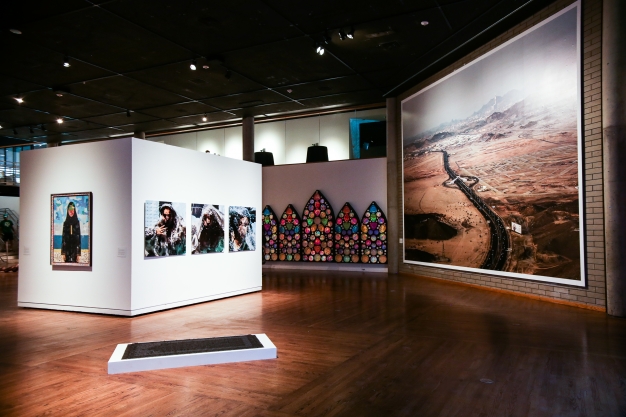
Exhibition view

Installation view of The World by Khalid Bin Afif

Exhibition view

Installation view of In Progress by Balqis AlRashed
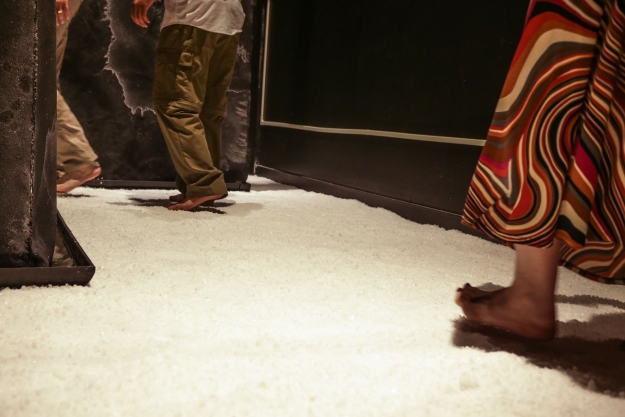
Installation view of In Progress by Balqis AlRashed
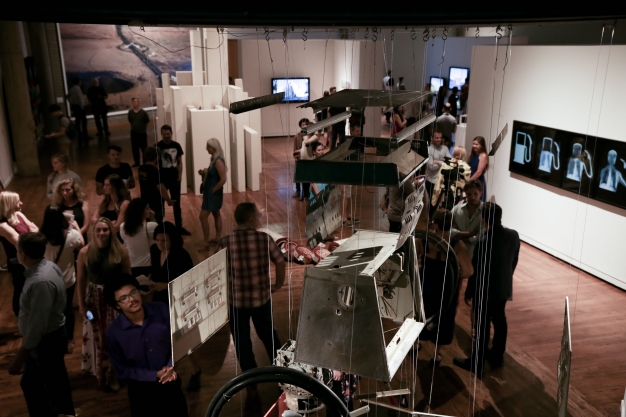
Exhibition view
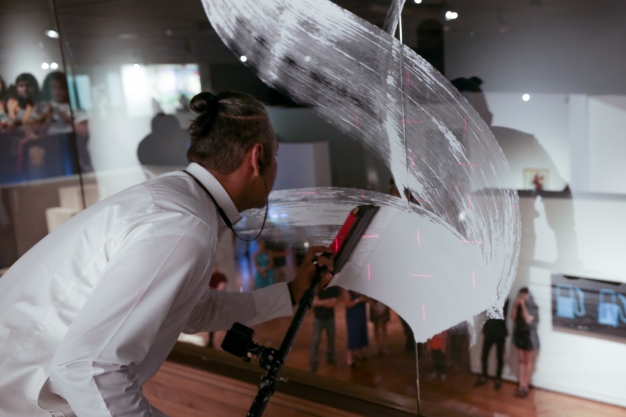
Nugamshi’s performance during the opening of Cities of Conviction
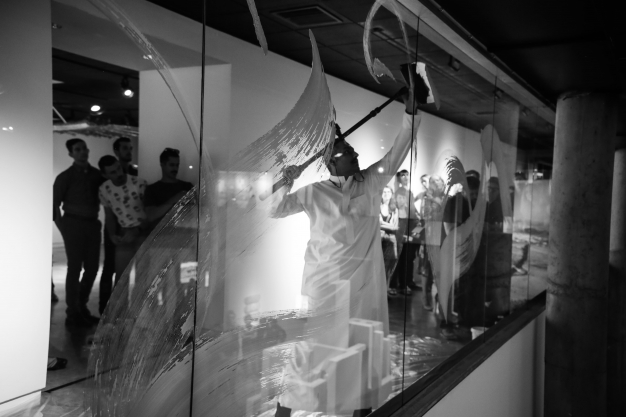
Nugamshi’s performance during the opening of Cities of Conviction

Installation View of Delicious by Rashed AlShashai
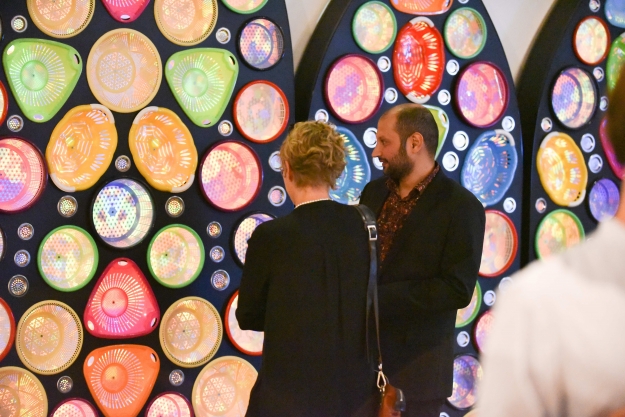
Rashed AlShashai discussing his work Heaven’s Door with an exhibition visitor
Cities of Conviction: Saudi Contemporary Art in Salt Lake City, UT represented the first exhibition of its kind from the Kingdom of Saudi Arabia to appear in Utah. This timely exhibition opened at the Utah Museum of Contemporary Art (UMOCA) on 25 August 2017 until 6 January 2018.
“Cities of Conviction examined the parallels between spiritual and urban cultures in Saudi Arabia and Utah; and especially the symbolism of creativity that connects cities of pilgrimage in both places,” said exhibition curator, Jared Steffensen. “Since the 7th Century, the holy cities of Makkah and Medina have drawn millions of Muslim pilgrims every year to worship at the holiest sites in Islam, the Kaaba (House of God) in Makkah and the Tomb of the Prophet in Medina. Salt Lake City was established nearly a thousand years later by Mormon pioneers in search of a safe haven for their newly established religion. Members of the Church of Latter Day Saints also make a twice-annual pilgrimage of the faithful to the General Conference at the spiritual center of the Mormon faith, Temple Square."
The common histories of these cities extend well beyond issues of faith. Cities across both Utah and Saudi Arabia arose from the desert; have laws driven, in large part, by the predominant religion, and at first blush have comparatively conservative cultures. Also, they have a youth culture pushing the boundaries of their culture through relentless individual expression while maintaining a sense of community.
These cities’ growth is limited and defined by their natural boundaries, valley walls, uninhabitable terrain and mountains; and both possess economies driven by access to natural resources. The discovery of oil in Saudi Arabia propelled its expansion, at times erasing architecture and history in favor of a more cosmopolitan feel, as evidenced by the commercial development projects being constructed around the sites of pilgrimage. This phenomenon is mirrored in recent debates over land use and energy resources across the state of Utah, from Bears Ears National Monument to the development of City Creek Center and the high-rise condominiums that literally look down onto Temple Square.
Cities of Conviction presented works from artists who are engaged in looking at the struggles and transformations of their society and delving into complex issues that link Utah and Saudi Arabia, such as oil, pilgrimage and tension surrounding commercial development around important cultural and religious heritage sites. From sacred lands to the way society condemns or accepts religious practices, each unique culture connects to one another in a variety of ways.
“Contemporary art has always been at the heart of these human connections, bringing to the forefront the most pressing issues of our national and global cultures,” says UMOCA Executive Director of Cities of Conviction, Kristian Anderson.
The artists included in Cities of Conviction use the visual language of art to explore the pertinent cultural issues facing Saudi Arabia and her citizens. They, as do many Utahns, question the long-term stability of relying on non-renewable resources to fund transformation. As Saudis inch towards a more globally-influenced culture, Salt Lake’s Latter-day Saint communities are moving towards accepting a more globally-influenced Salt Lake City, as the influx of new residents from all over the world changes the cultural landscape of Utah.
This exhibition sought to create an open dialogue about our understanding of Saudi faith and culture, as well as our own – and what these changes could mean for the citizens of Saudi Arabia and Utah.
Cities of Conviction: Saudi Contemporary Art in Salt Lake City, UT was organized by the Utah Museum of Contemporary Art in collaboration with King Abdulaziz Center for World Culture, and coordinated by CULTURUNNERS.
King Abdulaziz Center for World Culture, known as ithra, is a one-of-a-kind institution that brings together multiple offerings under one roof. From arts and culture to science and innovation, this bold initiative by Saudi Aramco promises a continuous journey of enrichment designed to energize the next knowledge economy of Saudi Arabia.
ithra aims to make a positive and tangible impact on the cultural scene by focusing on building local talents in the knowledge and creative industries. Blending iconic architectural design with advanced technology, and unique learning methods with enriching programs, ithra is an infinitely inspiring platform for explorers, learners, creators, and leaders–a thriving hub of knowledge, creativity and cross-cultural engagement.
As the Kingdom of Saudi Arabia strives to achieve its ambitious national development goals to transition to a knowledge-based economy, ithra acts as a bridge connecting cultures and cultivating a creative and innovative community.
The Utah Museum of Contemporary Art (UMOCA) has advanced and elevated the community of contemporary arts and culture since it was established in 1931. UMOCA is a fearless voice for innovation, experimentation and dialogue surrounding the topics of our time. Located in the heart of Salt Lake City, UMOCA invites curiosity and promotes understanding of the challenging concepts that art and its reflective social commentary can present. UMOCA is a force for social transformation that unites all points of view, backgrounds, experience, and ages through pertinent art exhibitions and educational programming. UMOCA evokes change, challenges ideologies, celebrates triumph, and introduces an array of contemporary voices with in the Museum and throughout the community.
Visit our Facebook Page
Follow us on Twitter
Follow us on Instagram
Visit our Youtube Channel
Visit our Tumblr profile
Visit our Instagram profile
×